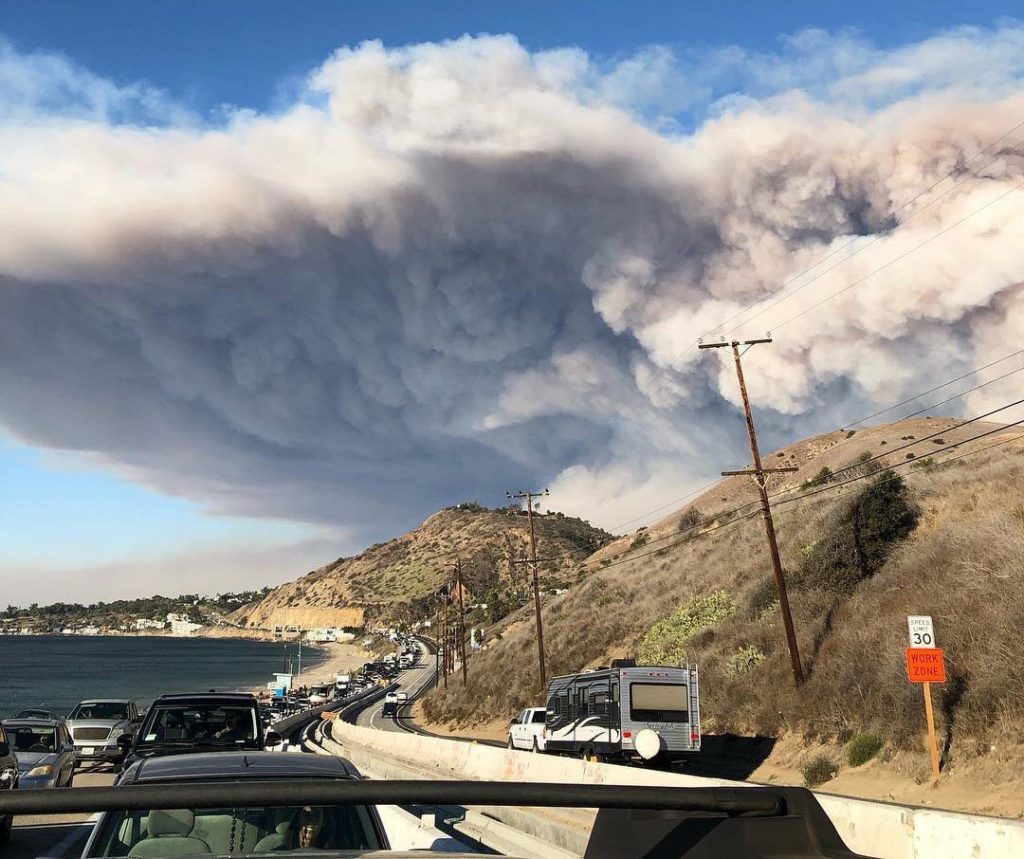
Officials & media dismiss catastrophic release of chemicals and radiation from Rocketdyne
“Shocked & furious to learn smoke from the #WoolseyFire started at former nuclear testing site, Santa Susana Field Lab, & is potentially radioactive,” tweeted mega-celebrity Kim Kardashian to her 58 million followers Nov. 14, six days after the devastating fire ignited. “Sign now to demand that incoming governor @GavinNewsom gets this site cleaned up: [No more kids with cancer: clean up the Santa Susana Field Lab]”
Kardashian has plenty of reason to be horrified. The Woolsey Fire started about 2:24 pm Nov. 8 on one of the most contaminated places in the state, the Santa Susana Field Laboratory (SSFL), commonly known as Rocketdyne, site of the nation’s worst partial nuclear reactor meltdown in 1959. The sprawling facility once housed 10 nuclear reactors, several of which also had serious accidents, and was the site of over 30,000 rocket-engine tests. These activities along with other accidents and poor environmental practices left the place severely contaminated. The site is still not cleaned up and toxins have been found offsite in every direction.
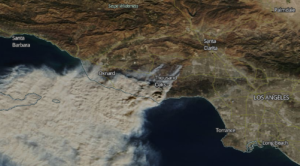
Over 2,404 acres of brush that covered 2,849-acre Rocketdyne burned in the Woolsey Fire, brush that sucks up radiation, trichloroethylene, dioxins, PCBs, and a cauldron of chemicals amongst a galaxy of ‘goo’ in the soil and groundwater, according to government reports obtained by EnviroReporter.com. Then it went up in smoke, 18 tons of it per acre. That’s over 43,272 tons of smoke particulate settling on thousands of properties in the shadow of SSFL. The toxic smoke and ash landed all over Southern California, where it is available to be re-suspended, landing again and bringing its molecular misery to unsuspecting masses for a long time to come.
A figurative smoke screen blocking the truth about the Woolsey Fire immediately kicked in. At 1:33 am the following morning, the state EPA’s Department of Toxic Substances Control (DTSC) sent out an urgent community update on the Woolsey Fire and SSFL. “The Woolsey Fire burned through a portion of the Santa Susana Field Laboratory (SSFL) yesterday,” the DTSC email read. “Our scientists and toxicologists have reviewed information about the fire’s location and do not believe the fire has caused any releases of hazardous materials that would pose a risk to people exposed to the smoke.”
That statement, and subsequent statements issued by DTSC as to the harmlessness of the smoke and ash, are unsubstantiated and at odds with the truth. DTSC also claimed that its “scientists and toxicologists have reviewed information about the fire’s location” yet see no danger. These ‘experts’ are well aware of the contamination in Rocketdyne’s soil and vegetation, and surely aware of what EnviroReporter.com found – government studies detailing a suite of dangerous substances sucked up by the brush and grasses at SSFL.
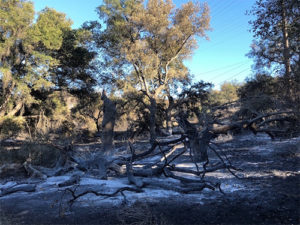
But instead of leveling with the public about the seriousness of this massive toxic release, DTSC claims – without disclosing any measurements or methods – that what’s left behind doesn’t test toxic. If past experience is any indicator, the agency will eventually release some of that data for the public to examine, and there will be all manner of problems with it.
Meanwhile area residents are left in the dark. After all, the real questions the public wants answered are 1) Was my family exposed to harmful radiation and chemicals from SSFL? 2) How could this have happened? and 3) What can I do about it now to mitigate it and so this doesn’t happen again?
Rocketdyne fire findings
EnviroReporter.com has found that DTSC and NASA misled the public about the fire’s potential consequences. EnviroReporter.com has also uncovered what may have been the cause of the massive blaze, how much Rocketdyne brush was incinerated, what was in that brush and where most of it landed.
Unfortunately many media outlets were willing to accept DTSC’s pronouncements that nothing toxic from SSFL was in the smoke and ash. Even Los Angeles magazine, which published this reporter’s very first Rocketdyne exposé in 1998, came out with a word salad trying to deny any problems with the hot smoke.
What EnviroReporter.com has found in the last twelve days and explores in depth:
● The Woolsey Fire was named after a reported fire-origin address 1.9 miles away and in another county. It should have been called the Rocketdyne Fire to be accurate and to warn the public about the smoke coming their way.
● The fire may have started when electrical lines, perhaps frayed, interacted with the tops of oaks during winds of 40 mph in NASA’s Area II. The treetops could have smoldered until sparks or embers ignited grasses and three small out buildings before really taking off towards the southwest and spreading out.
● At least 84 percent of SSFL burned launching approximately 43,272 tons of radioactive and chemically-impacted ash and smoke into the air.
● Department of Energy (DOE) reports from 2014 document the high levels of chlorinated dioxins/furans, polyaromatic hydrocarbons (PAHs), silver, cadmium and lead in its vegetation.
● Fire swept through Area I Burn Pit with high levels of 17 radionuclides and the most deadly form of dioxin, 2,3,7,8-TCDD, at 2,684.4 times its normal background.
● DTSC has these reports and knows full well about the possibility of radiation and chemicals in SSFL’s vegetation, yet still told the public the smoke was harmless.
● Toxic ash may impact properties not torched by the fire but in the fire’s impact zone.
● A 2005 fire burned 75% of Rocketdyne, illustrating that these recurring infernos will continue to release SSFL radiation and chemical contamination every time it catches fire, further contaminating the environment and exposing huge numbers of people and animals.
● DTSC, DOE, NASA and Boeing all have resisted full cleanup of SSFL.
● Save for KNBC Channel 4, most media discount the toxic stew released from Rocketdyne and refuse to acknowledge that the fire started on the site, not “near” it.
● Activists say Gov.-elect Gavin Newsom is key to a full cleanup of SSFL.
Reported fire origin location 2 miles from real start on Rocketdyne
The Woolsey Fire was strange from the moment it started, including how it got its name. Some early announcements listed 25000 Woolsey Canyon Rd. as the fire’s location. Cal Fire however tweeted the location at 4 pm as E Street and Alpha Road, which is clearly located on the Rocketdyne/Santa Susana Field Laboratory site itself. The name “Woolsey Fire” was immediately designated to the blaze, though the real fire origin at E Street and Alpha Road was about two miles away in another county from Rocketdyne.
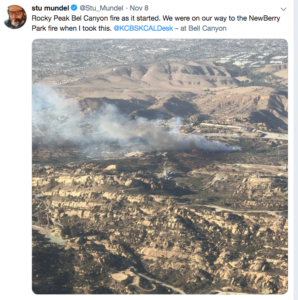
It’s no mystery where the fire did start – in Ventura County in SSFL’s Area II owned by NASA. The photo of its origins was taken by KTLA News Channel 5 Stu Mundel’s helicopter on the afternoon of Nov. 8. On Nov. 12, a longtime SSFL cleanup advocate, Physicians for Social Responsibility – Los Angeles, issued a press release that called out the fire’s origin.
“The tremendously destructive Woolsey Fire has been widely reported as beginning “near” the Santa Susana Field Laboratory (SSFL or Rocketdyne), but it appears that the fire began on the Rocketdyne property itself,” the press release said. “A photograph posted on Twitter from KCAL9’s Stu Mundel shows the fire starting Thursday afternoon near the same location, which is only about 1,000 yards away from the site of the 1959 partial nuclear meltdown of the Sodium Reactor Experiment (SRE) reactor.”
The photo went viral. So did PSR-LA’s strong criticism of DTSC. “The Woolsey Fire likely released and spread radiological and chemical contamination that was in SSFL’s soil and vegetation via smoke and ash,” said Dr. Bob Dodge, president of the two-time Nobel Peace Prizing winning group. “All wildfire smoke can be hazardous to health, but if SSFL had been cleaned up long ago as DTSC promised, we’d at least not have to worry about exposure to dangerous radionuclides and chemicals as well.”
Dodge is right, and DTSC did more than promise – in 2010, it signed legally binding agreements (Administrative Orders on Consent or AOCs) with the Department of Energy and NASA that required them to cleanup their areas of the site to background levels of contamination by 2017. DTSC also said in 2010 that even though Boeing would not sign an AOC agreement, it would require Boeing to cleanup according to Ventura County land use and zoning plans, which for Rocketdyne include agricultural and rural residential uses.
But community celebrations were short-lived. DOE and NASA began a series of actions that violated the AOC agreement, and Boeing fought back with a massive greenwashing campaign and in August 2017, announced it would clean up next to nothing by using weak recreational standards. Any hopes of DTSC enforcing the agreements were dashed last fall when the agency released a Draft Programmatic Environmental Impact Report that proposed leaving as much of 98% of the contamination on site.
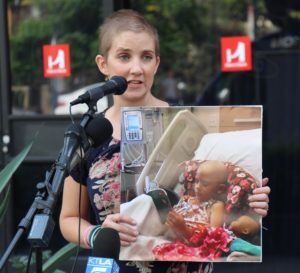
Community response to the Woolsey Fire reflected anger and mistrust of DTSC. “We’ve learned not to trust anything DTSC says, so we’re demanding independent testing and air monitoring for radiation and chemicals from SSFL,” said Melissa Bumstead, a West Hills resident whose daughter has twice survived leukemia that she believes was caused by Rocketdyne.
Bumstead’s Change.org petition urging that SSFL cleanup commitments be maintained has been signed by over 500,000 people. “DTSC has made one broken promise after another, and it wasn’t truthful about SSFL’s contamination long before the fire started.” said Bumstead. “Why would we believe DTSC’s statement that the fire caused no additional risk, when they know they’re the ones responsible for SSFL still being contaminated in the first place?”
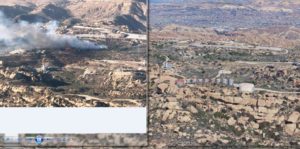
Fire’s origins and apparent cause
While no official explanation for Rocketdyne fire’s origin has been given, EnviroReporter.com analyzed Stu Mundel’s photo and utilizing Google Earth, ended up finding what may have been the start of the fire: an apparently frayed electric line whipping around in the top of an oak grove.
NASA was more than happy to talk about this oak grove in an April 2011 edition of its FieldNOTES, its “Newsletter on NASA’s Cleanup Efforts at Santa Susana Field Laboratory.” In it, NASA describes how well it has gone sucking up all the contamination around the trees from the Ash Pile debris area.
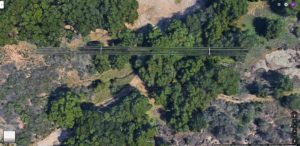
Unfortunately this small bit of remediation didn’t put a dent in the amount of contamination that needs to be cleaned up at Rocketdyne, allowing 18 tons of burnable brush per acre in California according to the Environmental Protection Agency (EPA) which calls it “estimated average fuel loading.”
NASA released its own statement on November 13, stating “Initial observations confirm significant fire damage across the NASA SSFL site. Fire swept through all three historic districts. The Alfa and Bravo test stands are scorched but intact. The Coca and Burro Flats cultural areas have not been safe to access.”
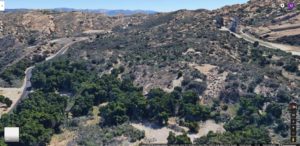
NASA joined in with DTSC in discounting any dangers from the fire using conditional phraseology that a top-notch lawyer could envy. “NASA recognizes all wildfires can present threats to the public, however we do not anticipate any specific risks from the fire associated with contamination at the site” it said, adding that “the California Department of Toxic Substances Control (DTSC) is actively monitoring the fire, and DTSC emergency response staff, scientists and toxicologists have reviewed information about the fire’s location and do not believe the fire has caused any releases of hazardous materials that would pose a risk to people exposed to the smoke.”
Not to be outdone, the Los Angeles County Department of Public Health claimed it didn’t find any radiation on a trip to SSFL after the fire, which is impossible as there is discernible background radiation everywhere on Earth except in a thickly shielded lead box.
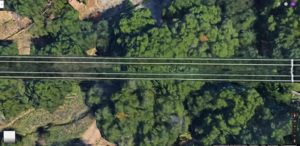
“Public Health officials traveled to the facility and performed nuclide identification, collected air samples, and operated multiple radiation detection units,” a Nov. 13 Public Health news release read. “There was no discernible level of radiation in the tested area. Public Health has discussed with the California Department of Toxic Substances and partner agencies their preliminary findings, and all found no evidence of discernible radiation in areas they tested around the facility.” [Our emphasis]
If this impossibility were true, then Rocketdyne would be the only place in the Universe with no “discernible radiation.” This inept statement shows either total stupidity or contempt for the truth or a combination of the two.
Chemicals in the smoke and ash
Both NASA and DTSC have also not been forthwith about what was in the smoke of burning Rocketdyne brush. Instead of sharing what they know about the contents of the plants that burned, they were apparently content to wave around Geiger counters and declare the place normal.
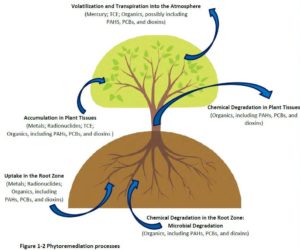
An extensive 2014 DOE report on SSFL “phytoremediation”, the study of flora sucking up contamination as a means of remediating land, provides an in-depth look at how SSFL contaminants are taken up by plants.
“The contaminants of interest (COI) for this study are a subset of the soil contaminants observed in Area IV and reflect the chemicals most amenable to phytoremediation,” the report said. “The COIs to be investigated for potential phytoremediation in this study are polyaromatic hydrocarbons (PAHs), total petroleum hydrocarbons (TPH), polychlorinated biphenyls (PCBs), polychlorinated dibenzo-p-dioxins (dioxins), and metals.”
The DOE report also showed that radionuclides and the carcinogenic rocket engine solvent trichloroethylene (TCE) “accumulation in plant tissues” in a colorful illustration. Nevertheless, the nuclear agency didn’t test radiation and TCE so abundant at Area IV but illustrated their presence in an educative illustration of a plant imbibing this noxious cocktail.
What DOE did test for came in with shocking results. They are even more shocking if one considers that these same plants were later incinerated in an out-of-control brushfire that started near to Area IV.
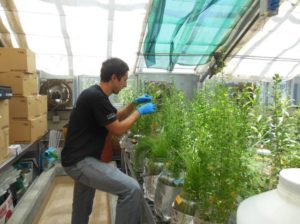
“PAH uptake by roots of several species was observed, with the highest PAH concentrations observed in the roots of Blue Elderberry (1,740 milligrams per kilogram [μg/kg]), Purple Needlegrass (700 μg/kg), and Yerba Santa (200 μg/kg) (note μg/kg is also parts per billion (ppb) by weight),” said the report called “Phytoremediation Study for the Santa Susana Field Laboratory Final Report 4/16/2015.”
“Chlorinated dioxins/furans were observed in the roots and foliage of several species, with the highest concentrations in the roots of Purple Needlegrass (2.2 μg/kg), Blue Elderberry (1.03 μg/kg), Palmer’s Goldenbush (0.43 μg/kg), and Yerba Santa (0.42 μg/kg), and the highest concentrations in the foliage of Yerba Santa (0.90 μg/kg), Palmer’s Goldenbush (0.76 μg/kg), and Purple Needlegrass (0.69 μg/kg).”
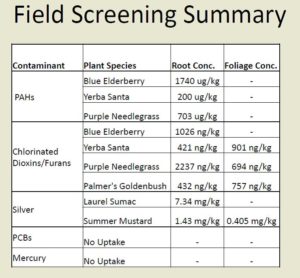
Finally, the study found “Silver uptake was observed in the roots of Laurel Sumac (7,300 μg/kg) and in the foliage of Summer Mustard (410 μg/kg).”
This is what burned at Rocketdyne and nearly all of it has vaporized and set sail upon the smoky winds. TCE and a rainbow of deadly radionuclides also went up in flames and spread.
Area I Burn Pit went up in flames
One of the most contaminated places at SSFL is the Area I Burn Pit, or more accurately, burn pits. Like the land around it, the burn pits must have been torched in the inferno night of Nov. 8 through Nov. 9 according to Cal Fire maps. EnviroReporter.com wrote about radiological and chemical contamination in these burn pits in 2016’s Critics question safety of Boeing’s Santa Susana Field Lab hikes:
Even as Boeing’s greenwashing guides lead unsuspecting hikers near the Burn Pit CC 1, the company itself said in this December 2013 report that to judge the extent of surface water migration of the burn pit, “It is recommended that soil samples be collected to characterize dioxins and furans, cyanide, metals, PCBs, pesticides, Perchlorate, and SVOCs in the drainage channels down gradient of the western side of Area I Burn Pit RFI [Resource Conservation and Recovery Act Facility Investigation] Site. Similarly, it is recommended that soil sample be collected to characterize mercury, dioxins and furans, cyanide, metals, PCBs, pesticides, energetics, and SVOCs in the drainage channels down gradient of the eastern side of Area I Burn Pit RFI Site.”
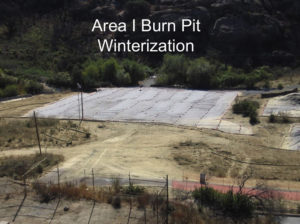
EnviroReporter.com also revealed in the exposé that “radium-226 was actually as high as 144.2 times background according to Boeing’s own numbers.” Boeing had already admitted that it had found the radionuclide, with a half-life of 1,600 years, radiating in the Burn Pit chemical cluster in nine areas with measurements of 1.7 to 9.6 times background.
In July 2006, DTSC ordered Boeing to remove an estimated 3,800 to 6,500 cubic yards of soil from the 3 to 5 acre-sized Area I Burn Pit. Yet it never happened and the place sat covered in thick rubberish tarps to keep the dust down, tarps that either melted or went up in flames nearly two weeks ago.
What went up with it, and which billowed and precipitated from the skies on Bell Canyon Estates, Ahmanson Ranch, Calabasas, Malibu and beyond could be Area I Burn Pit contagions that tested in the pits at huge levels.
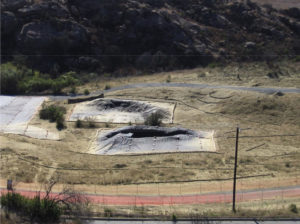
The most potent form of carcinogenic dioxin 2,3,7,8-TCDD in the burn pit was 2,684.4 times its “background threshold value” (BTV) or normal background. Radioisotope bismuth-214 came in at 67.5 times its BTV with lead-214 topping off at 65.5 times its background. Perhaps the most potent radioactive substance man has ever created, plutonium 239/240, glowed at 5.7 times its BTV.
In all, EnviroReporter.com found 17 dangerous radionuclides tipping the beam over their respective backgrounds including carcinogens cesium-137 and strontium-90. Boeing would be doing itself and the public a big favor assessing and reporting on the Area I Burn Pit immediately with readings and photographs. But then again, if Boeing and DTSC were that concerned about the public, Rocketydne would have been cleaned up long ago.
Misled media misleads public
Instead of taking a cautious, pragmatic approach to the fiery apocalypse, most media outlets took DTSC’s word and dismissed toxic warnings without, apparently, asking for proof. The worst coverage sneered at contamination worries.
The Los Angeles Times, while rescued by a billionaire from oblivion, continued its long history of tepid Rocketdyne reporting with the Nov. 12 article “No health risk from Woolsey fire that burned nuclear cleanup site, state officials say.” The piece intimated that SSFL cleanup activists were needlessly alarmist: “State regulators and outside experts are tamping down concerns from advocacy groups about the Woolsey fire, which burned part of the Santa Susana Field Laboratory nuclear cleanup site, saying it likely posed no risk to the public beyond what is normal for wildfire smoke.”
Therefore the smoke is normal and the activists need to have their fires put out? The Times quoted a professor of nuclear engineering who said that “the risk for health effects due to radiation is expected to be small.” Expected by whom, exactly, and based on what? The National Academy of Sciences’ Report on the Biological Effects of Ionizing Radiation found that there is no safe level of exposure to radiation. Children are more vulnerable to the impacts of radiation than adults, and girls more than boys. Implying otherwise gives a grave disservice to the community, literally.

The most surprising, and boldly bad, Rocketdyne fire reporting came from none other than Los Angeles magazine which, in 1998, published this reporter’s first SSFL exposé Hot Zone splashing “Special Investigation – A Nuclear Nightmare in Our Backyard” on the cover.
The piece caused a sensation but the 2018 version of Los Angeles sniffed at the fire’s contamination potential in its Nov. 9 post “Experts Say Rumors of “Radioactive Ash” from the Woolsey Fire Are Unsubstantiated.”
The article was subsequently criticized by commenters for putting quotation marks around Rocketdyne descriptor “significantly contaminated” as if it were a bugaboo used by those panicky advocates who also like to banter about “Radioactive Ash.”
The Los Angeles piece also included this:
“The responding fire agencies from Ventura and Los Angeles Counties also consulted independent hazardous materials coordinators who agreed with the conclusion that toxic material from the site was unlikely to have been spread due to the fire.”
Where then did it go then since the site is likely burnt bare like a charred moonscape? Much of it is obviously no longer there. Much of what used to make Los Angeles magazine occasionally great is obviously no longer there either. To its credit, the magazine did print a correction and has not blocked the outraged comments to the reporter’s post on the magazine’s website.
CBS-LA also repeated agency denials in Officials: Santa Susana Nuclear Site Safe From Woolsey Fire, along with taking the extra step of showing buildings from Area IV with a caption that the buildings weren’t damaged in the fire – as if that meant there was nothing to worry about.
One exception to the media misinformation is KNBC Channel 4’s Joel Grover, who has been fearless in exposing the environmental fiasco that is the Santa Susana Field Laboratory. KNBC‘s ongoing fire coverage has been a breath of fresh air compared to the smoke-screen SSFL information has to go through.
Out of the ashes can come a chance for expedited comprehensive cleanup
The contaminated ash may continue to expose people, but there are important precautions that can be taken. The home environment demands HEPA air filters and any chance of encountering fire-impacted dust or ash outside should be met with an N95 facemask and removing shoes when entering homes. Kids’ outdoor activities in the impacted zones need to be reassessed on an individual basis with the default actions being very protective (i.e. restrictive).
Because of the prevailing direction of the wind, the Rocketdyne fire ash settled in great amounts on and around the Malibu Canyon corridor to the beach. Rains will soon start washing that contamination down into Malibu Creek and the runoff will eventually make its way to the Pacific Ocean.
Beyond that, with no action by the public to force the full cleanup of SSFL to background levels of contamination, these kinds of massive radioactive and chemically-infused fires will happen again and again.
But a newly informed public outraged by the Rocketdyne fire may find in itself the power to demand that Governor-elect Newsom replace the leadership of DTSC and its entire SSFL team. A little celebrity firepower just might make that happen.
Community groups like Parents vs SSFL and the Rocketdyne Cleanup Coalition are helping many of the people new to this vast and complex issue understand it and join the fight to make sure it can never happen again. Perhaps more powerful celebrities, like the ones burned out of their mansions, might also make that leap.
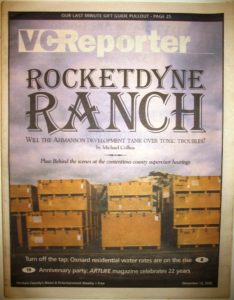
After all, the community has had its share of victories. Washington Mutual’s Ahmanson Ranch project, which would have built 3,050 homes in the fire’s path in what is now called the Upper Las Virgenes Open Space Preserve, was stopped by environmental reporting hence thousands of new homes weren’t burnt down in the fire and human lives possibly lost.
The community also stopped an ill-intended scheme by cleanup opponents to get the Agency for Toxic Substances and Disease Registry to dismiss independent studies that show increased cancers near Rocketdyne and declare the cleanup unnecessary.
More recently, the community succeeding in stopping plans to build hiking trails near Rocketdyne. That part of the Los Angeles County Santa Susana Mountain Trails Master Plan to build Toxic Trails was nixed, due to concerns about “trail planning efforts near the facility, where the level of cleanup is yet to be determined.”
Now it will be up to California’s new governor, Gavin Newsom, to make sure Rocketdyne is finally and fully cleaned up. DTSC, NASA, DOE and Boeing all know exactly what contamination is where and how much of it is there. The new governor should demand that DTSC direct these polluters to get cracking and bulldoze the polluted dirt out of the place before new brush covers it up again.
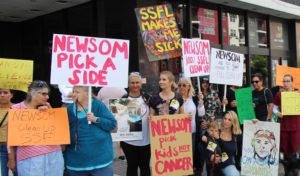
“Our family lives ONLY 20 miles from a nuclear disaster site, Santa Susana Field Lab, and we didn’t even know it – the #WoolseyFire started there, and smoke could be carrying radioactive chemicals,” Kourtney Kardashian tweeted Nov. 14. “We need @GavinNewsom to do something – sign the petition. https://www.change.org/p/no-more-kids-with-cancer-clean-up-the-santa-susana-field-lab …”
Another generation of sick kids may result because of this Rocketdyne fire. Perhaps mothers and their allies, some rich and some not so much, will finally force DTSC and the polluters to do what they already promised to do years ago before the Boeing greenwashers arrived.
It would be the one spark from the Rocketdyne fire that would make some of the heartbreak not suffered in vain. With the stars aligning and the truth laid bare here, there has never been a better chance to clean up Rocketdyne completely and without any more delay.
27 Years of Award-Winning SSFL/Rocketdyne Reporting
1998 – 2025
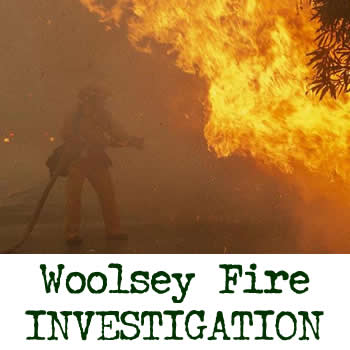












There is a long article on the Los Angeles Times website today (1/08/19) about the prospect that the Northern California electrical power company Pacific Gas & Electric aka PG&E may be forced to file a Chapter 11 bankruptcy, or sell of a significant portion of PG&Ed’s assets to pay all of the tort claims and lawsuits it is facing as a result of the 86+ deaths and widespread destruction of buildings which occurred in the “Camp” Fire.
Without going into a long winded economic analysis of where Southern California Edison (SCE) stands eonomically as a result of the Woolsey Fire allegedly starting because of a malfunction of SCE’s equipment on the Santa Susana Field Lab property.
Here’s a comment on what would happen if PG&E filed a Chapter 11 bankruptcy again. If you read it and think about the similar problem faced by Southern California Edison (SCE) as a result of the damages caused by the Woolsey Fire, you’ll get a sense of how things would work if SCE filed a Chapter 11 bankruptcy too.
“On April 7, 2001 PG&E filed its first Chapter 11 bankruptcy. PG&E did NOT ask the California Public Utilities Commission for permission, their bankruptcy lawyers simply went to the Bankruptcy Court building in San Francisco and did it. As a result today’s California Public Utilities Commission Chairman, Mike Picker, is a complete moron and 100% wrong when he says that PG&E has to get the PUC’s permission before filing a bankruptcy case this year.
The reason PUC Chairman Picker’s comment is idiotic and absolutely wrong is because the Supremacy Clause of the United States Constitution (Article VI, Clause 2) establishes that the Constitution, Federal laws enacted pursuant to it, and Federal court rules like the U.S. Bankruptcy Court Rules made under the Constitution’s authority, constitute the “supreme law of the land”. State Constitutions and their provisions, State laws and State agency regulations are subordinate to Federal law including the “Bankruptcy Code” and “Bankruptcy Rules” which govern how a bankrupt company, its management and lawyers operate once a bankruptcy case is filed.
During the 2001 Chapter 11 bankruptcy filed by PG&E the State of California and its Public Utilities Commission (PUC) did not get crosswise with the Bankruptcy Court judge who handled the PG&E case, or with the 9th Circuit Bankruptcy Appellate Panel (BAP), in large part because the State had competent Chapter 11 bankruptcy lawyers advising it. As a matter of window dressing (because of the Supremacy Clause) the State and the PUC refused to directly participate in that PG&E bankruptcy case, and the bankruptcy judge who presided over the case did not decide or do anything major which would have angered the lawyers for the State.
The beauty of a Chapter 11 bankruptcy filing for a troubled company is that as long as the company’s senior management are honest, the Bankruptcy Court judge will let senior management stay as the people running the company and making important decisions.
The other beauty of a Chapter 11 bankruptcy is that a provision in bankruptcy law called the “Automatic Stay” means that nobody can sue the company without the bankruptcy judge’s permission, or take other adverse actions against the company unless the judge approves. In the case of a “public utility” like PG&E the State of California, its Public Utilities Commission (PUC) and local governments cannot “tell the pubic utility what-to-do” without the bankruptcy judge’s consent, such as the PUC telling PG&E that they cannot sell their natural gas distribution business to raise cash.
The Automatic Stay also means that the State of California and the PUC cannot enforce any state law concerning development of green energy sources by PG&E unless the Bankruptcy Court judge presiding over a PG&E Chapter 11 case approves. The PUC also cannot fine PG&E for not complying with the green energy laws, even if the Legislature passes new laws which attempt to “get around” the Automatic Stay.
All in all the filing of a Chapter 11 bankruptcy by PG&E would allow its management to run the company free of interference by the State, by employee unions and by small creditors like the green energy power producers. In essence a Chapter 11 produces a short term Valhalla for a utility company’s management, including a customary bankruptcy court order which allows the bankrupt company to pay bonuses to senior managers “so they won’t quit”.
PG&E is facing 100 or so wrongful death lawsuits in California Superior Courts which are likely to take a long time to resolve. Those cases CANNOT be brought as a “class action” to speed up resolution of them because each fire victim’s death involves different facts.
In addition PG&E is facing thousands of lawsuits from private property owners and their fire insurance companies who blame PG&E’s policies, PG&E employees’ actions and inaction for causing at least 3 gigantic wildfires. Various and sundry local government agencies will sue PG&E for damage to their property as well. On top of all of that time consuming and ultimately financially disastrous litigation, because PG&E probably does not have enough liability insurance, PG&E is also going to be sued under California law for the costs to the State and local governments in fighting those fires.
In a typical Chapter 11 case where the debtor company has more tort liability to third parties than it has liability insurance, the debtor company typically makes a motion asking that all of the tort claimants be forced to litigate with the debtor company’s insurance carrier(s) and to “leave the debtor company out of it” by the bankruptcy court judge ordering that the tort claimant creditors CANNOT recover money judgments arising out of those claims from anyone but the debtor company’s liability insurer. Soon after PG&E files its upcoming Chapter 11 bankruptcy case I full expect such a motion will be made. PG&E’s senior management will reason and decide that it is better for them personally and the company to offload all of the tort litigation onto PG&E’s liability insurance carrier(s) sooner rather than later.
The problem, of course, is that PG&E’s management and lawyers know that PG&E’s liability insurance policies do not provide enough insurance coverage to pay off all of the wildfire tort claims as they mature into court judgments. It’s a swell idea to sell off PG&E’s natural gas distribution business to try to raise money to supplement its liability insurance, so that the wildfire related tort claims can be settled and paid. However, there is a huge problem with that strategy over and above the PUC and the shareholders not liking the “sell the gas company plan”. Under California and Federal law PG&E is obligated to treat all of its unsecured creditors equally, which wouldn’t happen if the proceeds of a gas company sale were set aside only to be used for the wildfire related creditors. PG&E’s unsecured creditors would start loudly objecting by claiming that the sale is a “fraudulent conveyance” under California law. Those claims would likely kill any outside-of-bankruptcy-court deal to sell PG&E’s gas business.
There are only 2 feasible ways for PG&E to sell its natural gas distribution business to raise cash: Through a “Section 363 sale free and clear of liens claims or encumbrances” or through the content of a Chapter 11 Plan of Reorganization, in either case requiring approve from PG&E’s “new” bankruptcy court judge. PG&E’s shareholders, lenders, unionized employees and the California Public Utilities Commission can have screaming fits about such a sale, but they would not have the authority to stop it. There’s no means under California law to do such a sale of PG&E’s natural gas distribution business and shake off all of the claims by angry creditors, angry employees and angry fire victims. That’s why a Chapter 11 bankruptcy is the only means available for PG&E’s senior management to unravel all of its serious problems in a well organized, lawful way.”
Michael Collins’ article exposing the truth about the Woolsey Fire on the Santa Susana Field Lab property is a cogent explanation of the risk to members of the public living near that property. The article illustrates why real estate brokers and sales people doing business in the surrounding community breach their fiduciary duty of full disclosure to their home buyer customers who innocently purchase or rent houses or condos within a several mile radius of the Field Lab.
Like many other people have done over the years, in 1981 I bought a home 2.5 miles, as the crow flies, from radioactively contaminated Area IV of the Santa Susana Field Lab. The house was located just a few blocks north of the foot of the gigantic ridge and hill between Sinaloa Road and First Street in Simi Valley. When the Santa Ana Winds would blow from east to west, the house would be noisily scoured by dirt and dust particles. That’s how I knew that we were being bombarded by dirt and dust blown at us from the east, the constant sound of each particle hitting our east facing windows.
Like thousands of home buyers before me and after me, absolutely no disclosure was made to me by the house’s seller or its real estate broker or salesmen that atop the hillside and ridge I could see out the living room window had been the site of the worst nuclear accident in U.S. history, a partial melt down of the fuel rods in a nuclear reactor in 1959.
No one told me that there had been 10 experimental nuclear reactors up on the top of that ridge.
No one told me, that the 10 reactors lacked containment structures (like those at Three Mile Island or San Onofre) which would have kept-inside most of the radioactive particles from the partial melt-down or from additional accidents at those reactors.
No one told me not to ingest the dirt and dust which had blown onto my home site since 1959.
When I bought that house in Simi Valley it had no landscaping. I spent 6 months-worth of Saturdays and Sundays digging up the soil on that lot, (including the time when I was pregnant with my son,) digging and jack hammering that soil to create holes large enough for the root balls of 15 gallon trees and 5 gallon plants. I didn’t wear a mask while doing that digging because no one told me about the escape of radioactive particles from the nuclear accidents which occurred on the top of the ridge which I could see while digging up the soil in my front and back yards.
While living in that house my kids would play out in the back yard, where there was no grass to cover that 10,000 square feet of dirt, trees and bushes.. Often they would come back into the house covered in dirt. We would wash it away and their dirt covered clothes would end up in the washing machine with other clothes.
There are informal hiking trails and horse trails on the hill sides/mountain sides northwest of Area IV, the place where the ill-fated nuclear reactors were located along with a big “burn pit” where radioactively contaminated materials like used rags and gloves would be burned. Between the Santa Ana Winds blowing from east to west, and the Burn Pit smoke which would be carried in the wind and be deposited on the ground and on the grass/plants just waiting for adventurous boys, hikers, riders and their horses to be randomly sprinkled with radioactive particles on the ground or blown in the wind.
Back in 1997 I met a lawyer who later grew up to be a hot shot plaintiff’s lawyer. He happened to tell me that he and his wife had cutting horses and that their horse-riding was at the center of their weekends. Imagine my surprise when I read that the lawyer had bought a home where horse-keeping is allowed in Simi Valley and that he had to fight off the Woolsey Fire as it came down the hillside into his neighborhood. https://www.law.com/therecorder/2018/11/16/calif-lawyers-battle-wildfires-as-they-prepare-lawsuits-we-were-at-ground-zero/?slreturn=20181118131648 It turns out his home was built on part of the field across the street from my family’s old dust-blasted home near Area IV. His story made me wonder if the real estate brokers and agents involved in his purchase of his horse-keeping-house in the dusty, wind blown highlands of Simi Valley had disclosed the full story about the Rocketdyne Reactors to him.
I think we need a Robert Mueller-style investigation of the DTSC. Consider:
* Enviroreporter has been reporting on this for YEARS
* This was completely PREDICTABLE
* The DTSC blew it off ANYWAY.
Seriously, and without exaggeration, someone is ON THE TAKE, and they need to go to JAIL.
Melissa Bumstead at Parents Against SSFL has a new update at her Change.org petition demanding full cleanup of the Santa Susana Field Laboratory. It’s called “An insult to those already suffering” regarding new California Governor Gavin Newsom’s appointment of Boeing’s former shill fighting cleanup of Rocketdyne as his top lobbyist. Newsom will soon feel the heat over this as apparently he has already forgotten his limp endorsement of full cleanup of the lab.
From our friends at Physicians for Social Responsibility – Los Angeles and Parents Against SSFL:
In the face of widespread distrust of reassurances by the troubled state toxics agency, community members near the Santa Susana Field Laboratory (SSFL), a heavily contaminated nuclear and rocket testing facility in the LA area, will participate in an independent study of potential migration of contamination from the site during the recent Woolsey Fire. Fairewinds Energy Education, a non-profit organization founded by former nuclear industry scientists, will conduct the study of dust or soil samples collected from homes in the area and sent to a laboratory on the East Coast for measurements.
The Woolsey fire began on November 8 at SSFL and burned much of the site, which is contaminated from decades of nuclear and rocket-engine testing, including a partial nuclear meltdown in 1959. Government assurances that the fire did not risk heightened exposures to SSFL contamination have been been met with distrust and skepticism, in part because the very entities claiming there was no toxic risk from the SSFL fire are the ones responsible for contaminating it in the first place and breaching commitments to clean it up.
The agency reassurances lack credibility, in large measure because:
– Within hours of the fire, with no data whatsoever, the Department of Toxic Substances Control (DTSC) issued a statement claiming there were no releases of radioactive or toxic materials.
– DTSC claimed in that statement that no areas with contamination had burned. Subsequent satellite photos and admissions by the Responsible Parties demonstrated that a large portion of the site did burn, much of it contaminated. Later DTSC statements tried to walk back its initial false claims. DOE similarly initially claimed the fire hadn’t touched any of its area, Area IV. Satellite photos also disproved that assertion, and DOE retracted it.
– Days after the fire at SSFL stopped, DTSC said it and others took measurements. But the primary concern was release of contamination during the fire, i.e., in the smoke. This is like someone visiting the site of a mass shooting days later and reporting there are no bullets flying; what is of primary concern are the bullets during the shooting.
– DTSC reported that measurements taken days after the fire found no contamination, even at SSFL, even though DTSC has for decades acknowledged the site is in fact heavily contaminated, which is why extensive cleanup has been required in cleanup agreements between DTSC and the polluters. The U.S. EPA conducted a $40 million, multi-year study which found 500 locations at SSFL with elevated radioactivity.
– DTSC’s claims that its post-fire measurements could find no contaminated at SSFL even though extensive contamination at the site is undisputed, suggests that (1) the measurements are so insensitive they cannot detect contamination that is there, (2) they are inflating background values to make real contamination appear not to be there, (3) they are lying about their results. If the measurements were somehow correct, and there is no longer any contamination at SSFL after the fire, it would mean the fire drove off all contamination from SSFL into the outlying communities. The claims of being unable to detect any contamination, even at the polluted SSFL sites, raise serious questions about the validity of DTSC’s statements.
– DTSC wholly fails to explain how a fire can burn hundreds of acres of contaminated vegetation growing in contaminated soil and not release some of those contaminants. It is a scientific impossibility.
– Community members and elected officials have repeatedly asked DTSC to disclose all data and methodology to back up its vague assurances, but four weeks after the fire no data whatsoever have been released.
– “DTSC says at some point it will release a summary of its conclusions, suggesting it is taking weeks to ‘massage’ the data,” said Denise Duffield, Associate Director of Physicians for Social Responsibility-Los Angeles (PSR-LA.)
– At a Nov. 15 press conference, Governor Brown said he too was “very skeptical” of assurances by his own agencies that there were no toxic releases from the fire at SSFL.
In the absence of credible, trustworthy government assessments of the risk of radioactive releases from the fire, the Fairewinds study will rely on “citizen scientists” and volunteers to carefully collect samples of dust or soil from area homes and property. Samples will be analyzed by the Fairewinds team, who released a detailed sampling protocol for the project. PSR-LA and Parents vs SSFL have assembled a team of trained staff and volunteers to assist with sample collection. “I’m excited to be a part of this project and serve my community,” said Jeni Knack, a Simi Valley resident with prior training in sampling who will help lead field operations. “We’ve already received over 150 requests for sampling assistance from residents.”
Health advocates are grateful for the study, though they acknowledge its limitations. It occurs after the fire is over, when a primary risk was inhalation of radioactivity carried in the smoke while SSFL burned. The study will focus solely on radionuclides, not the many hazardous chemicals that have contaminated SSFL’s soil and vegetation. Further, it may not be possible to identify whether radioactive particles migrated before or after the Woolsey fire. “We understand the study won’t address all concerns,” said Duffield. “Contamination from SSFL has been migrating offsite for years, and now the Woolsey fire may have caused even more migration. We’re grateful that Fairewinds is bringing its experience and expertise to the SSFL community..”
Melissa Bumstead, a West Hills resident whose young daughter has twice survived a rare leukemia she blames on SSFL, agrees. “Given what our family and our community have been through, it’s horrible that we even have to worry about potentially radioactive smoke and ash by the Woolsey fire,” Bumstead said. Bumstead has mapped over 50 rare pediatric cancers in the area, and launched a Change.org petition for cleanup that has been signed by over 528,000 people. “I don’t trust DTSC at all. They’re responsible for cleaning up the site’s contamination but they continue to benefit SSFL’s site-owner, Boeing, instead of the community.”
Community members and health advocates say that their biggest focus now is ensuring that SSFL is finally and fully cleaned up. “Our greatest frustration remains that if DTSC had kept its word, the site would be cleaned up by now and we wouldn’t have new worries related to the fire,” Duffield said. In 2010, DTSC signed agreements with the Department of Energy and NASA that committed them to clean up all detectable contamination in their operational areas by 2017. DTSC also in 2010 committed to require Boeing, which owns most of the site, to cleanup to comparable standards.
But the cleanup has not yet begun, and DTSC is currently considering proposals that will leave much, if not all, of SSFL’s contamination on site permanently. Boeing mounted a formidable greenwashing campaign against full cleanup and DTSC issued a draft Environmental Impact Report (EIR) last year indicating that much of the contamination would not be cleaned up. Community members worry that if the EIR is finalized soon, their hopes for the full, promised cleanup will be forever dashed.
“We’re asking governor-elect Newsom to step in now,” Bumstead said, “We need him to direct DTSC to honor its cleanup commitments and radically reform that agency. They’ve failed us and other communities across California. We’re thankful to Fairewinds for getting involved and helping us make decisions based on trustworthy data.”
Residents who are interested in participating in the study can go to http://bit.ly/SSFLstudy to sign up. Reporters who wish to accompany study participants collecting samples should contact Denise Duffield at dduffield@psr-la.org or 213-589-9170.
# # #
Physicians for Social Responsibility-Los Angeles (PSR-LA) is the largest chapter of the national organization Physicians for Social Responsibility and has worked for the full cleanup of SSFL for over 30 years.. PSR-LA advocates for policies and practices that protect public health from nuclear and environmental threats and eliminate health disparities.
Parents vs. SSFL is a grassroots group of concerned parents and residents who demand compliance with cleanup agreements signed in 2010 that require a full cleanup of all radioactive and chemical contamination at the Santa Susana Field Laboratory.
Around 2:45 p.m. on Thursday, November 8th 2018 I walked outside my work in Thousand Oaks to see the massive clouds of smoke from the Hill Fire. Stunning and frightening because the winds were so very wicked at that time. My first thought was that thank goodness parts of the area had burned 3 years earlier and that maybe there wouldn’t be as much fuel. I turned to re enter my work and saw the plume near Oak Park. I immediately logged on to Ventura County Fire Department’s Pulsepoint web-site to get location on fire near Oak Park. I am familiar with the region due to volunteerism in area with habitat restoration projects. The fire had an entry on VCFD Pulsepoint as “3 Rocketdyne”* with 9 units responding. I immediately texted a friend who works for Ventura County. They verified that yes, indeed, this fire was was on site at SSFL and that it was “barreling” towards Oak Park. This was around 3:00 p.m. I called friends and associates in the Oak Park Area to notify them that there was a fire behind them, headed their direction, and that should be prepared and alert. The first one I called said “Oh no, that’s smoke from a fire in Camarillo.” I advised them that I was looking at VCFD web-site and had verification from County. They were then able to alert their neighbors and be prepared.
A little after 3:00 p.m. the ” 3 Rocketdyne Fire” incident dropped completely from the VCFD Pulspoint web-site. I have never seen an incident entirely “vanish” from the web-site. I trained with CERT a little over a year ago and have made it a habit over the past year to frequently check incidents and status of incidents on the Pulsepoint web-site especially after the Thomas Fire.
NEVER have I seen an incident simply “vanish” from the site. I fished around on the internet and found that L.A. County Fire had tweeted that they were in Mutual Aid Response on site at SSFL and that VCFD PIO would be handling all public information. I went back to VCFD Pulsepoint to see if post had “refreshed”. It hadn’t. I left work at 7:00 p.m. and checked the VCFD Pulsepoint web-site repeatedly for 4 hours and it never returned as an incident until sometime after 7:30 p.m. when it was renamed “Woolsey Fire.”
So what? Well, people who use the web-site to prepare and notify were left in the dark….entirely. People who were out of the area and used the site to gather which way to return home were left in the dark and news agencies were also, left in the dark for more than 4 hours. This is dangerous and deplorable and we cannot surmise a reputable explanation for the name change and subsequent “dropping” of the incident from our public information resource. Why the name change? and at what expense? We lost hours where seconds and minutes count. While we were able to notify some key people in some areas and also to activate livestock owners, it was not enough. It simply was not enough. We want answers. Does a fire named Woolsey burn less fast and furious than a fire named Rocketdyne? Who made this decision to change names, drop public information and leave us in the dark? Why?
* MICHAEL COLLINS – That would seem to be code for Area III of Rocketdyne – close to where the Rocketdyne/Woolsey fire started – making this account even more believable, pertinent and outrageous on the part of the person or people who did this. The changing of the name was no inadvertent mistake. It had intent to not inform the public of the true origins, with its attendant threats, of the Rocketdyne fire just as we exposed in this piece. Thank you, Cecile, for this excellent information.
Thank you so much for exposing the truth and informing all who live in So. Cal about the dangers of exposure to these toxins. All of us who live here should be concerned about our health as a result of this fire. What have we breathed into our bodies? What have we been exposed to? Rocketdyne MUST be cleaned up once and for all. I’m so sick of being lied to by state and federal agencies who “supposedly” are the ones charged with protecting us from dangers like this. Our world has been turned upside down by corporate polluters and the elected officials, state and federal agencies who collude with them. Enough is enough.
Thank you for a most informative piece of journalism. You did a great job. It is up to us, the public, to put pressure on those representing us to get the Rocketdyne area cleaned up as soon as possible. Politicians work for us. If they don’t do their job in getting the Rocketdyne area cleaned up , then we need to make a change and get rid of those who aren’t willing to stand up to large corporations to get the job done.
I’m troubled that Federal and State agencies charged with the responsibility to protect the environment and the safety of the public seem to only study the SSFL contamination problem. Those agencies agree there is contamination, agree to clean it up, and then do very little to actually mitigate or even monitor the spread of the poisons they know are present at dangerous levels. What is the public to do? Should someone sue for damages? Should our court systems be utilized to compel action by the public agencies? The public pays taxes to fund what exactly? To serve the public good, or just study how badly our safety and interests have been trampled in the past? Maybe their studies should be mandated to include an annual body count, or a topographical map showing excess cancer cases surrounding the SSFL area. Their is a cost to infinite delay. Can’t we at least install permanent air and ground water monitoring stations that empirically monitor the gradual seepage of contaminated ground water or the sudden bursts of air contamination due to wild fires?
Thank you Michael Collins. Keep writing and exposing the dangers of contamination at SSFL. The rest of us need to wake up and pass the word on to our neighbors.
Thank you for this article and real journalistic work.
I am increasingly disgusted by the for-profit and all for-sale attitude of most industries and governments, which have abused this planet as if there was no tomorrow.
And there won’t be a tomorrow if we don’t come to our senses and clean up the messes we’ve brought onto Earth.
Our biosphere is collapsing and we better act today if we want to keep this planet habitable.
Thank you for the article and your real journalism.
Over and over again, I am disgusted by the abundance of for profit and for sale driven industries and governments.
The US would be such beautiful country, however, it’s being destroyed and abused repeatedly as if there was no tomorrow. And soon there won’t be a tomorrow if human civilization doesn’t come to it’s senses and doesn’t clean up the mess we’ve created for the sake of greed, war and power.
History shows they’re not to be trusted.
If full cleanup is too costly, then add that cost to the cost of rockets and nuclear reactors. Maybe that would make one think twice about building so many.
Great article and Accurate – I wish the DTSC were as forthcoming
Great reporting–when I heard the fire had started at Rocketdyne, my heart sank. Anyone with any sense knows what’s in that ash…
Michael
Once again your great reporting has shed the light of truth about this site.
The community is grateful for your reporting the truth.